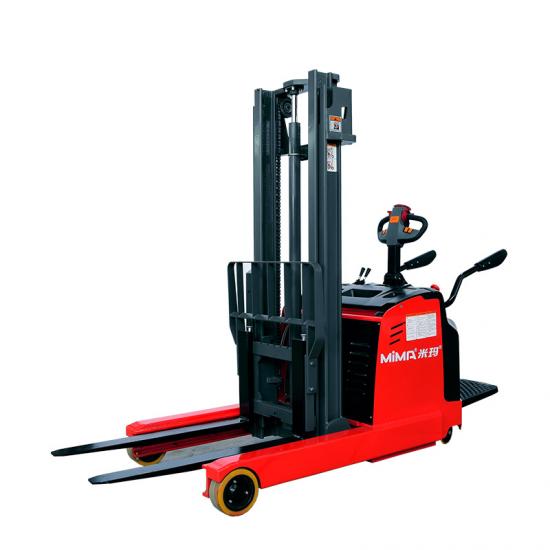A Stacker Trailer designed by RPM Trailer Sales will allow you to safely haul multiple cars, or any of your precious cargo in an 'over and under' configuration and thus avoid excessive trailer lengths. Load and unload trucks from the ground or use it as a portable work platform to simplify maintenance tasks. When compared with counterbalance forklifts, Crown pallet stackers allow you to stack more products in the same size room by narrowing the required aisle width, which translates into more usable space while optimizing selectivity.
A stacker is a large machine used in bulk material handling. Its function is to pile bulk material such as limestone, ores and cereals on to a stockpile. A reclaimer can be used to recover the material.
Gold dredges in Alaska had a stacker that was a fixed part of the dredge. It carried over-size material to the tailings pile.
Stackers are nominally rated for capacity in tonnes per hour (tph). They normally travel on a rail between stockpiles in the stockyard. A stacker can usually move in at least two directions: horizontally along the rail and vertically by luffing (raising and lowering) its boom. Luffing of the boom minimises dust by reducing the distance that material such as coal needs to fall to the top of the stockpile. The boom is luffed upwards as the height of the stockpile increases. Some stackers can rotate the boom. This allows a single stacker to form two stockpiles, one on either side of the conveyor.
Stackers are used to stack in different patterns, such as cone stacking and chevron stacking. Stacking in a single cone tends to cause size segregation, with coarser material moving out towards the base. In raw cone ply stacking, additional cones are added next to the first cone. In chevron stacking, the stacker travels along the length of the stockpile adding layer upon layer of material.

Stackers and reclaimers were originally manually controlled, with no means of remote control. Modern machines are typically semi-automatic or fully automated, with parameters remotely set. The control system used is typically a programmable logic controller, with a human-machine interface for display, connected to a central control system.
Other than stacking, a stacker has three basic movements:
- Luffing: This is vertical movement. Stackers use either a winch mechanism with metal wire, or hydraulic cylinders, generally two. Winch mechanisms are highly reliable compared to hydraulic actuators and remain widely used, particularly in large stackers.
- Travelling: The stacker moves on a rail track, which may be broad or narrow gauge, enabling it to move around the stockyard as required. For this purpose, traction motors powered by direct current (DC) are connected by bevel gears to between 12 and 22 wheels. For manual control, all the controls are in a controller's cabin above the boom conveyor or boom. Modern stackers can be controlled remotely.
- Slewing: This is rotation of the stacker around its central axis to align or place the stockpile where required. This works mostly by a slew pinion that rotates around a slew base. This type of gear assembly is called a sun and planet gear. The axles may be multiple and are driven by DC-powered axle motors which transmit the torque via bevel or helical gears.
The conveyor belts used in stackers may be made of fabric or metal wire, depending upon the material to be handled. They are driven by pulleys, which in turn are driven by DC motors. The motors and gear are coupled by fluid coupling.
Most stackers are electrically powered by way of a trailing cable. There are basically two types of cable trailing: power cord rotating drum (PCRD) and control cable rotating drum (CCRD). Pendulum adjustments are made to ensure the proper alignment of these cables while the stacker is travelling.
See also[edit]
| Look up stacker in Wiktionary, the free dictionary. |
External links[edit]
| Wikimedia Commons has media related to Stackers. |
References[edit]
Electric high-lift pallet truck
Robust and powerful high lift trucks
With CLARK high-lift pallet trucks with load capacities from 1,000 to 2,000 kg, you always have the organisation of your warehouse under control – whether in industry, trade or logistics. Even through the narrowest of aisles you can move up to two tonnes effortlessly with these compact and manoeuvrable pallet trucks. CLARK high lift trucks also prove their worth when loading and unloading lorries. The sturdy CLARK mast of the electric high-lift trucks allows high residual capacities even at high lift heights. Thanks to the compact dimensions of the pedestrian stackers, safe handling is possible without any problems even in confined spaces. Do you need a pedestrian pallet truck or, for longer distances, a pallet truck with an operator platform? No problem: CLARK offers the right electric pedestrian pallet truck model for almost every requirement.
div > .uk-panel', row:true}'>Electric stacker WS10
Pedestrian-operated machine
Mono or standard upright
Capacity: 1000 kg
WS10
Electric stacker WSX12/14
Pedestrian-operated machine
Capacity: 1200 / 1400 kg
WSX12/14
Electric stacker SX12/16
Pedestrian-operated machine / platform version
Optional: initial lift
Capacity: 1200 / 1600 kg

SX12/16
Electric stacker WSXD20
Pedestrian-operated machine - multi-purpose vehicle
Stacker Truck Hire
Capacity: 2000 kg

WSXD20
Electric stacker PSX16
Foldable driver's platform and side safety guards
Capacity: 1600 kg
Stacker Truck
PSX16
